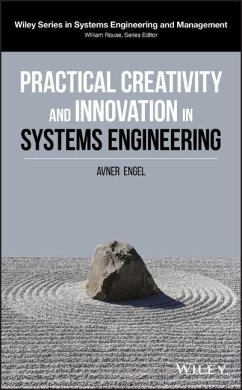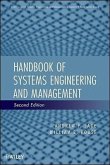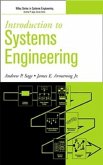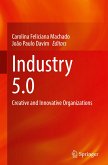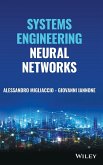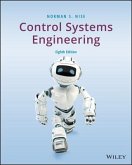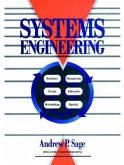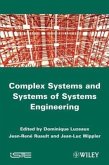Avner Engel
Practical Creativity and Innovation in Systems Engineering
Avner Engel
Practical Creativity and Innovation in Systems Engineering
- Gebundenes Buch
- Merkliste
- Auf die Merkliste
- Bewerten Bewerten
- Teilen
- Produkt teilen
- Produkterinnerung
- Produkterinnerung
A guide to systems engineering that highlights creativity and innovation in order to foster great ideas and carry them out Practical Creativity and Innovation in Systems Engineering exposes engineers to a broad set of creative methods they can adopt in their daily practices. In addition, this book guides engineers to become entrepreneurs within traditional engineering companies, promoting creative and innovative culture around them. The author describes basic systems engineering concepts and includes an abbreviated summary of Standard 15288 systems' life cycle processes. He then provides an…mehr
Andere Kunden interessierten sich auch für
![Handbook of Systems Engineering and Management Handbook of Systems Engineering and Management]() Andrew P SageHandbook of Systems Engineering and Management309,99 €
Andrew P SageHandbook of Systems Engineering and Management309,99 €![Introduction to Systems Engineering Introduction to Systems Engineering]() Andrew P SageIntroduction to Systems Engineering199,99 €
Andrew P SageIntroduction to Systems Engineering199,99 €![Industry 5.0 Industry 5.0]() Industry 5.0112,99 €
Industry 5.0112,99 €![Systems Engineering Neural Networks Systems Engineering Neural Networks]() Alessandro MigliaccioSystems Engineering Neural Networks119,99 €
Alessandro MigliaccioSystems Engineering Neural Networks119,99 €![Control Systems Engineering Control Systems Engineering]() Norman S NiseControl Systems Engineering192,99 €
Norman S NiseControl Systems Engineering192,99 €![Systems Engineering Systems Engineering]() Andrew P SageSystems Engineering193,99 €
Andrew P SageSystems Engineering193,99 €![Large-Scale Complex System and Systems of Systems Large-Scale Complex System and Systems of Systems]() Large-Scale Complex System and Systems of Systems225,99 €
Large-Scale Complex System and Systems of Systems225,99 €-
-
-
A guide to systems engineering that highlights creativity and innovation in order to foster great ideas and carry them out Practical Creativity and Innovation in Systems Engineering exposes engineers to a broad set of creative methods they can adopt in their daily practices. In addition, this book guides engineers to become entrepreneurs within traditional engineering companies, promoting creative and innovative culture around them. The author describes basic systems engineering concepts and includes an abbreviated summary of Standard 15288 systems' life cycle processes. He then provides an extensive collection of practical creative methods which are linked to the various systems' life cycle processes. Next, the author discusses obstacles to innovation and, in particular, how engineers can push creative ideas through layers of reactionary bureaucracy within non-innovative organizations. Finally, the author provides a comprehensive description of an exemplary creative and innovative case study recently completed. The book is filled with illustrative examples and offers effective guidelines that can enhance individual engineers' creative prowess as well as be used to create an organizational culture where creativity and innovation flourishes. This important book: * Offers typical systems engineering processes that can be accomplished in creative ways throughout the development and post-development portions of a system's lifetime. * Includes a large collection of practical creative methods applicable to engineering and other technological domains * Includes innovation advice needed to transform creative ideas into new products, services, businesses and marketing processes * Contains references and notes for further reading in every section Written for systems engineering practitioners, graduate school students and faculty members of systems, electrical, aerospace, mechanical and industrial engineering schools, Practical Creativity and Innovation in Systems Engineering offers a useful guide for creating a culture that promotes innovation.
Produktdetails
- Produktdetails
- Verlag: Wiley
- Seitenzahl: 512
- Erscheinungstermin: 16. Oktober 2018
- Englisch
- Abmessung: 236mm x 158mm x 30mm
- Gewicht: 952g
- ISBN-13: 9781119383239
- ISBN-10: 1119383234
- Artikelnr.: 50991892
- Herstellerkennzeichnung
- Libri GmbH
- Europaallee 1
- 36244 Bad Hersfeld
- gpsr@libri.de
- Verlag: Wiley
- Seitenzahl: 512
- Erscheinungstermin: 16. Oktober 2018
- Englisch
- Abmessung: 236mm x 158mm x 30mm
- Gewicht: 952g
- ISBN-13: 9781119383239
- ISBN-10: 1119383234
- Artikelnr.: 50991892
- Herstellerkennzeichnung
- Libri GmbH
- Europaallee 1
- 36244 Bad Hersfeld
- gpsr@libri.de
AVNER ENGEL, PhD, has 45 years' experience in areas of software programming, systems and software engineering, technical management within large firms in the United States and Israel, academic teaching, and scientific research. He is the author of Verification, Validation and Testing of Engineered Systems, published by Wiley as part of Wiley's Systems Engineering and Management Series. Dr. Engel is currently with the Tel Aviv University ? Systems Engineering Research Institute (TAU-SERI).
Contents Preface xiii Acknowledgments xv Part I Introduction 1 1.1 Introduction to Part I 1 1.2 Systems Engineering 4 1.3 Creative Methods 5 1.4 Promoting Innovative Culture 6 1.5 Creative and Innovative Case Study 8 1.6 Back Matter 9 1.7 Bibliography 10 Part II Systems Engineering 11 2.1 Introduction to Part II 11 2.2 Basic Systems Engineering Concepts 13 2.2.1 Essence of Systems Engineering 13 2.2.2 Organizations and Projects Concepts 13 2.2.3 System Concepts 14 2.2.4 Life Cycle Concepts 16 2.2.5 Process Concepts 18 2.2.6 Further Reading 19 2.3 Standard 15288 Processes 19 2.3.1 Agreement Process Group 20 2.3.2 Organizational Project
Enabling Process Group 21 2.3.3 Technical Management Process Group 25 2.3.4 Technical Process Group 31 2.3.5 Further Reading 44 2.4 Philosophy of Engineering 44 2.4.1 Engineering and Truth 45 2.4.2 The Logic of Engineering Design 46 2.4.3 The Context and Nature of Engineering Design 48 2.4.4 Roles and Rules and the Modeling of SociöTechnical Systems 51 2.4.5 Engineering as Synthesis - Doing Right Things and Doing Things Right 54 2.4.6 Further Reading 57 2.5 Bibliography 57 Part III Creative Methods 59 3.1 Introduction to Part III 59 3.2 Divergent Methods for Individuals 61 3.2.1 Lateral Thinking 61 3.2.2 Resolving Contradictions 68 3.2.3 Biomimicry Engineering 76 3.2.4 Visual Creativity (Three Methods) 80 3.3 Divergent Methods for Teams 88 3.3.1 Classic Brainstorming 88 3.3.2 Six Thinking Hats 91 3.3.3 SWOT Analysis 94 3.3.4 SCAMPER Analysis 100 3.3.5 Focus Groups 103 3.4 Convergent Methods for Individuals 105 3.4.1 PMI Analysis 105 3.4.2 Morphological Analysis 110 3.4.3 Decision Tree Analysis 112 3.4.4 Value Analysis/Value Engineering 116 3.4.5 Pareto Analysis 122 3.5 Convergent Methods for Teams 124 3.5.1 Delphi Method 124 3.5.2 SAST Analysis 129 3.5.3 Cause
and
Effect Diagram 134 3.5.4 Kano Model Analysis 137 3.5.5 Group Decisions: Theoretical Background 142 3.5.6 Group Decisions: Practical Methods 150 3.6 Other Creative Methods 156 3.6.1 Process Map Analysis 157 3.6.2 Nine
Screens Analysis 160 3.6.3 Technology Forecasting 165 3.6.4 Design Structure Matrix Analysis 172 3.6.5 Failure Mode Effect Analysis 175 3.6.6 Anticipatory Failure Determination 184 3.6.7 Conflict Analysis and Resolution 191 3.7 Bibliography 198 Part IV Promoting Innovative Culture 205 4.1 Introduction to Part IV 205 4.2 Systems Evolution 207 4.2.1 Modeling Systems Evolution - S
Curve 207 4.2.2 Laws of Systems Evolution 209 4.2.3 Further Reading 226 4.3 Modeling the Innovation Process 226 4.3.1 Classes and Types of Innovations 226 4.3.2 Technological Innovation Process 228 4.3.3 Innovation Funding 235 4.3.4 Further Reading 239 4.4 Measuring Creativity and Innovation 239 4.4.1 Defining Innovation Objectives 239 4.4.2 Measuring the Innovation Process 241 4.4.3 Innovation Capability Maturity Model 246 4.4.4 Further Reading 250 4.5 Obstacles to Innovation 250 4.5.1 Human Habits Factors 250 4.5.2 Costs Factors 252 4.5.3 Institutional Factors 252 4.5.4 Knowledge Factors 253 4.5.5 Markets Factors 253 4.5.6 Innovation Obstacles and Classes of Innovations 254 4.5.7 Further Reading 255 4.6 Promoting Organization's Innovative Culture 255 4.6.1 Introduction 255 4.6.2 Innovation and Leadership 256 4.6.3 Innovation and Organization 259 4.6.4 Innovation and People 260 4.6.5 Innovation and Assets 262 4.6.6 Innovation and Culture 264 4.6.7 Innovation and Values 267 4.6.8 Innovation and Processes 268 4.6.9 Innovation and Tools 268 4.6.10 Conclusion: Ascent to Innovation: Practical Steps 271 4.6.11 Further Reading 274 4.7 Pushing Creative Ideas by Individual Engineers 275 4.7.1 Large Organizations Seldom Innovate 275 4.7.2 Characteristics of Innovative Engineers 280 4.7.3 Innovation Advice to Creative Engineers 285 4.7.4 Further Reading 290 4.8 Human Diversity and Gendered Innovation 290 4.8.1 Human Diversity 290 4.8.2 Shift in Gender Paradigm 292 4.8.3 Gender Disparity and Innovation Implications 295 4.8.4 Advancing Gendered Innovation 298 4.8.5 Gendered Innovation Example 304 4.8.6 Further Reading 308 4.9 Cognitive Biases and Decision
Making 308 4.9.1 Cognitive Biases 309 4.9.2 Cognitive Biases and Strategic Decisions 315 4.9.3 Further Reading 318 4.10 Bibliography 319 Part V Creative and Innovative Case Study 327 5.1 Introduction to Part V 327 5.2 A Problem Seeking a Solution 329 5.2.1 The Problem and Its Inception 329 5.2.2 Initial Funding Effort 331 5.2.3 Further Reading 331 5.3 Gaining Deeper Insights 331 5.3.1 The Problem and the Approach 332 5.3.2 Main Ideas of the Proposed Work 334 5.3.3 Measurable Project Objectives 336 5.3.4 Basis for Predicting the Objectives 337 5.3.5 Systems Adaptability: State
of
the
Art 340 5.3.6 Further Reading 345 5.4 Project Planning 346 5.4.1 Project Planned Activities 346 5.4.2 Detailed Work Package Descriptions 359 5.4.3 Risks and Contingency Plans 372 5.4.4 Management Structure and Procedures 375 5.4.5 Project Participants 382 5.4.6 Resources Needed 387 5.5 The AMISA Project 388 5.5.1 AMISA Initiation 388 5.5.2 Identifying the DFA State
of
the
Art 389 5.5.3 Establishing Requirements for AMISA 390 5.5.4 Implementing a Software Support Tool 390 5.5.5 Developing Six Pilot Projects 391 5.5.6 Generating Deliverables 397 5.5.7 Planning Exploitation beyond AMISA 399 5.5.8 Disseminating Project Results 399 5.5.9 Assessing the AMISA Project 400 5.5.10 Consortium Meetings 402 5.5.11 EC Summary of the Project 405 5.5.12 Further Reading 408 5.6 Architecture Options Theory 408 5.6.1 Financial and Engineering Options 408 5.6.2 Transaction Costs and Interface Costs 410 5.6.3 Architecture Adaptability Value 412 5.6.4 Design Structure Matrix 413 5.6.5 Dynamic System Value Modeling 414 5.6.6 Further Reading 417 5.7 Architecture Options Example 417 5.7.1 Step 1: Define the System and Its Environment 418 5.7.2 Step 2: Decompose the System Architecture 419 5.7.3 Step 3: Determine a Time Horizon for System Upgrade 419 5.7.4 Step 4: Determine Option Value (OV) of Each Component 422 5.7.5 Step 5: Determine Interface Cost (IC) of Each Interface 426 5.7.6 Step 6: Model the System by Way of Design Structure Matrix (DSM) 427 5.7.7 Step 7: Compute Base System's AAV 428 5.7.8 Step 8: Define Components' Exclusion Sets 428 5.7.9 Step 9: Optimize the System Architecture (Merging) 431 5.7.10 Step 10: Perform Sensitivity Analyses 434 5.7.11 Step 11: Evaluate Alternative System Architectures 438 5.7.12 Step 12: Define System Variants 439 5.7.13 Step 13: Estimate the Optimal Upgrade Time 441 5.7.14 Further Reading 442 5.8 AMISA - Endnote 442 5.9 Bibliography 444 Appendix A Life Cycle Processes versus Recommended Creative Methods 447 Appendix B Extended Laws of Technical Systems Evolution 451 B.1 Law 1: System Convergence 452 B.2 Laws 2 to 7: Systems Merging 452 B.3 Law 8: Flow Conductivity 456 B.4 Laws 9 to 14: Enhanced Coordination 458 B.5 Law 15: Controllability 462 B.6 Law 16: Dynamization 463 B.7 Law 17: Transition to Super System 463 B.8 Law 18: Increasing System Completeness 465 B.9 Law 19: Displacement of Human 466 B.10 Law 20: Uneven System Evolution 466 B.11 Law 21: Technology General Progress 467 Appendix C List of Acronyms 469 Appendix D Permissions to Use Third
Party Copyright Material 475 D.1 Part I: Introduction 475 D.2 Part II: Systems Engineering 475 D.3 Part III: Creative Methods 476 D.4 Part IV: Promoting Innovative Culture 477 D.5 Part V: Creative and Innovative Case Study 479 D.6 Appendices 480 Index 483 Wiley Series in Systems Engineering and Management 491
Enabling Process Group 21 2.3.3 Technical Management Process Group 25 2.3.4 Technical Process Group 31 2.3.5 Further Reading 44 2.4 Philosophy of Engineering 44 2.4.1 Engineering and Truth 45 2.4.2 The Logic of Engineering Design 46 2.4.3 The Context and Nature of Engineering Design 48 2.4.4 Roles and Rules and the Modeling of SociöTechnical Systems 51 2.4.5 Engineering as Synthesis - Doing Right Things and Doing Things Right 54 2.4.6 Further Reading 57 2.5 Bibliography 57 Part III Creative Methods 59 3.1 Introduction to Part III 59 3.2 Divergent Methods for Individuals 61 3.2.1 Lateral Thinking 61 3.2.2 Resolving Contradictions 68 3.2.3 Biomimicry Engineering 76 3.2.4 Visual Creativity (Three Methods) 80 3.3 Divergent Methods for Teams 88 3.3.1 Classic Brainstorming 88 3.3.2 Six Thinking Hats 91 3.3.3 SWOT Analysis 94 3.3.4 SCAMPER Analysis 100 3.3.5 Focus Groups 103 3.4 Convergent Methods for Individuals 105 3.4.1 PMI Analysis 105 3.4.2 Morphological Analysis 110 3.4.3 Decision Tree Analysis 112 3.4.4 Value Analysis/Value Engineering 116 3.4.5 Pareto Analysis 122 3.5 Convergent Methods for Teams 124 3.5.1 Delphi Method 124 3.5.2 SAST Analysis 129 3.5.3 Cause
and
Effect Diagram 134 3.5.4 Kano Model Analysis 137 3.5.5 Group Decisions: Theoretical Background 142 3.5.6 Group Decisions: Practical Methods 150 3.6 Other Creative Methods 156 3.6.1 Process Map Analysis 157 3.6.2 Nine
Screens Analysis 160 3.6.3 Technology Forecasting 165 3.6.4 Design Structure Matrix Analysis 172 3.6.5 Failure Mode Effect Analysis 175 3.6.6 Anticipatory Failure Determination 184 3.6.7 Conflict Analysis and Resolution 191 3.7 Bibliography 198 Part IV Promoting Innovative Culture 205 4.1 Introduction to Part IV 205 4.2 Systems Evolution 207 4.2.1 Modeling Systems Evolution - S
Curve 207 4.2.2 Laws of Systems Evolution 209 4.2.3 Further Reading 226 4.3 Modeling the Innovation Process 226 4.3.1 Classes and Types of Innovations 226 4.3.2 Technological Innovation Process 228 4.3.3 Innovation Funding 235 4.3.4 Further Reading 239 4.4 Measuring Creativity and Innovation 239 4.4.1 Defining Innovation Objectives 239 4.4.2 Measuring the Innovation Process 241 4.4.3 Innovation Capability Maturity Model 246 4.4.4 Further Reading 250 4.5 Obstacles to Innovation 250 4.5.1 Human Habits Factors 250 4.5.2 Costs Factors 252 4.5.3 Institutional Factors 252 4.5.4 Knowledge Factors 253 4.5.5 Markets Factors 253 4.5.6 Innovation Obstacles and Classes of Innovations 254 4.5.7 Further Reading 255 4.6 Promoting Organization's Innovative Culture 255 4.6.1 Introduction 255 4.6.2 Innovation and Leadership 256 4.6.3 Innovation and Organization 259 4.6.4 Innovation and People 260 4.6.5 Innovation and Assets 262 4.6.6 Innovation and Culture 264 4.6.7 Innovation and Values 267 4.6.8 Innovation and Processes 268 4.6.9 Innovation and Tools 268 4.6.10 Conclusion: Ascent to Innovation: Practical Steps 271 4.6.11 Further Reading 274 4.7 Pushing Creative Ideas by Individual Engineers 275 4.7.1 Large Organizations Seldom Innovate 275 4.7.2 Characteristics of Innovative Engineers 280 4.7.3 Innovation Advice to Creative Engineers 285 4.7.4 Further Reading 290 4.8 Human Diversity and Gendered Innovation 290 4.8.1 Human Diversity 290 4.8.2 Shift in Gender Paradigm 292 4.8.3 Gender Disparity and Innovation Implications 295 4.8.4 Advancing Gendered Innovation 298 4.8.5 Gendered Innovation Example 304 4.8.6 Further Reading 308 4.9 Cognitive Biases and Decision
Making 308 4.9.1 Cognitive Biases 309 4.9.2 Cognitive Biases and Strategic Decisions 315 4.9.3 Further Reading 318 4.10 Bibliography 319 Part V Creative and Innovative Case Study 327 5.1 Introduction to Part V 327 5.2 A Problem Seeking a Solution 329 5.2.1 The Problem and Its Inception 329 5.2.2 Initial Funding Effort 331 5.2.3 Further Reading 331 5.3 Gaining Deeper Insights 331 5.3.1 The Problem and the Approach 332 5.3.2 Main Ideas of the Proposed Work 334 5.3.3 Measurable Project Objectives 336 5.3.4 Basis for Predicting the Objectives 337 5.3.5 Systems Adaptability: State
of
the
Art 340 5.3.6 Further Reading 345 5.4 Project Planning 346 5.4.1 Project Planned Activities 346 5.4.2 Detailed Work Package Descriptions 359 5.4.3 Risks and Contingency Plans 372 5.4.4 Management Structure and Procedures 375 5.4.5 Project Participants 382 5.4.6 Resources Needed 387 5.5 The AMISA Project 388 5.5.1 AMISA Initiation 388 5.5.2 Identifying the DFA State
of
the
Art 389 5.5.3 Establishing Requirements for AMISA 390 5.5.4 Implementing a Software Support Tool 390 5.5.5 Developing Six Pilot Projects 391 5.5.6 Generating Deliverables 397 5.5.7 Planning Exploitation beyond AMISA 399 5.5.8 Disseminating Project Results 399 5.5.9 Assessing the AMISA Project 400 5.5.10 Consortium Meetings 402 5.5.11 EC Summary of the Project 405 5.5.12 Further Reading 408 5.6 Architecture Options Theory 408 5.6.1 Financial and Engineering Options 408 5.6.2 Transaction Costs and Interface Costs 410 5.6.3 Architecture Adaptability Value 412 5.6.4 Design Structure Matrix 413 5.6.5 Dynamic System Value Modeling 414 5.6.6 Further Reading 417 5.7 Architecture Options Example 417 5.7.1 Step 1: Define the System and Its Environment 418 5.7.2 Step 2: Decompose the System Architecture 419 5.7.3 Step 3: Determine a Time Horizon for System Upgrade 419 5.7.4 Step 4: Determine Option Value (OV) of Each Component 422 5.7.5 Step 5: Determine Interface Cost (IC) of Each Interface 426 5.7.6 Step 6: Model the System by Way of Design Structure Matrix (DSM) 427 5.7.7 Step 7: Compute Base System's AAV 428 5.7.8 Step 8: Define Components' Exclusion Sets 428 5.7.9 Step 9: Optimize the System Architecture (Merging) 431 5.7.10 Step 10: Perform Sensitivity Analyses 434 5.7.11 Step 11: Evaluate Alternative System Architectures 438 5.7.12 Step 12: Define System Variants 439 5.7.13 Step 13: Estimate the Optimal Upgrade Time 441 5.7.14 Further Reading 442 5.8 AMISA - Endnote 442 5.9 Bibliography 444 Appendix A Life Cycle Processes versus Recommended Creative Methods 447 Appendix B Extended Laws of Technical Systems Evolution 451 B.1 Law 1: System Convergence 452 B.2 Laws 2 to 7: Systems Merging 452 B.3 Law 8: Flow Conductivity 456 B.4 Laws 9 to 14: Enhanced Coordination 458 B.5 Law 15: Controllability 462 B.6 Law 16: Dynamization 463 B.7 Law 17: Transition to Super System 463 B.8 Law 18: Increasing System Completeness 465 B.9 Law 19: Displacement of Human 466 B.10 Law 20: Uneven System Evolution 466 B.11 Law 21: Technology General Progress 467 Appendix C List of Acronyms 469 Appendix D Permissions to Use Third
Party Copyright Material 475 D.1 Part I: Introduction 475 D.2 Part II: Systems Engineering 475 D.3 Part III: Creative Methods 476 D.4 Part IV: Promoting Innovative Culture 477 D.5 Part V: Creative and Innovative Case Study 479 D.6 Appendices 480 Index 483 Wiley Series in Systems Engineering and Management 491
Contents Preface xiii Acknowledgments xv Part I Introduction 1 1.1 Introduction to Part I 1 1.2 Systems Engineering 4 1.3 Creative Methods 5 1.4 Promoting Innovative Culture 6 1.5 Creative and Innovative Case Study 8 1.6 Back Matter 9 1.7 Bibliography 10 Part II Systems Engineering 11 2.1 Introduction to Part II 11 2.2 Basic Systems Engineering Concepts 13 2.2.1 Essence of Systems Engineering 13 2.2.2 Organizations and Projects Concepts 13 2.2.3 System Concepts 14 2.2.4 Life Cycle Concepts 16 2.2.5 Process Concepts 18 2.2.6 Further Reading 19 2.3 Standard 15288 Processes 19 2.3.1 Agreement Process Group 20 2.3.2 Organizational Project
Enabling Process Group 21 2.3.3 Technical Management Process Group 25 2.3.4 Technical Process Group 31 2.3.5 Further Reading 44 2.4 Philosophy of Engineering 44 2.4.1 Engineering and Truth 45 2.4.2 The Logic of Engineering Design 46 2.4.3 The Context and Nature of Engineering Design 48 2.4.4 Roles and Rules and the Modeling of SociöTechnical Systems 51 2.4.5 Engineering as Synthesis - Doing Right Things and Doing Things Right 54 2.4.6 Further Reading 57 2.5 Bibliography 57 Part III Creative Methods 59 3.1 Introduction to Part III 59 3.2 Divergent Methods for Individuals 61 3.2.1 Lateral Thinking 61 3.2.2 Resolving Contradictions 68 3.2.3 Biomimicry Engineering 76 3.2.4 Visual Creativity (Three Methods) 80 3.3 Divergent Methods for Teams 88 3.3.1 Classic Brainstorming 88 3.3.2 Six Thinking Hats 91 3.3.3 SWOT Analysis 94 3.3.4 SCAMPER Analysis 100 3.3.5 Focus Groups 103 3.4 Convergent Methods for Individuals 105 3.4.1 PMI Analysis 105 3.4.2 Morphological Analysis 110 3.4.3 Decision Tree Analysis 112 3.4.4 Value Analysis/Value Engineering 116 3.4.5 Pareto Analysis 122 3.5 Convergent Methods for Teams 124 3.5.1 Delphi Method 124 3.5.2 SAST Analysis 129 3.5.3 Cause
and
Effect Diagram 134 3.5.4 Kano Model Analysis 137 3.5.5 Group Decisions: Theoretical Background 142 3.5.6 Group Decisions: Practical Methods 150 3.6 Other Creative Methods 156 3.6.1 Process Map Analysis 157 3.6.2 Nine
Screens Analysis 160 3.6.3 Technology Forecasting 165 3.6.4 Design Structure Matrix Analysis 172 3.6.5 Failure Mode Effect Analysis 175 3.6.6 Anticipatory Failure Determination 184 3.6.7 Conflict Analysis and Resolution 191 3.7 Bibliography 198 Part IV Promoting Innovative Culture 205 4.1 Introduction to Part IV 205 4.2 Systems Evolution 207 4.2.1 Modeling Systems Evolution - S
Curve 207 4.2.2 Laws of Systems Evolution 209 4.2.3 Further Reading 226 4.3 Modeling the Innovation Process 226 4.3.1 Classes and Types of Innovations 226 4.3.2 Technological Innovation Process 228 4.3.3 Innovation Funding 235 4.3.4 Further Reading 239 4.4 Measuring Creativity and Innovation 239 4.4.1 Defining Innovation Objectives 239 4.4.2 Measuring the Innovation Process 241 4.4.3 Innovation Capability Maturity Model 246 4.4.4 Further Reading 250 4.5 Obstacles to Innovation 250 4.5.1 Human Habits Factors 250 4.5.2 Costs Factors 252 4.5.3 Institutional Factors 252 4.5.4 Knowledge Factors 253 4.5.5 Markets Factors 253 4.5.6 Innovation Obstacles and Classes of Innovations 254 4.5.7 Further Reading 255 4.6 Promoting Organization's Innovative Culture 255 4.6.1 Introduction 255 4.6.2 Innovation and Leadership 256 4.6.3 Innovation and Organization 259 4.6.4 Innovation and People 260 4.6.5 Innovation and Assets 262 4.6.6 Innovation and Culture 264 4.6.7 Innovation and Values 267 4.6.8 Innovation and Processes 268 4.6.9 Innovation and Tools 268 4.6.10 Conclusion: Ascent to Innovation: Practical Steps 271 4.6.11 Further Reading 274 4.7 Pushing Creative Ideas by Individual Engineers 275 4.7.1 Large Organizations Seldom Innovate 275 4.7.2 Characteristics of Innovative Engineers 280 4.7.3 Innovation Advice to Creative Engineers 285 4.7.4 Further Reading 290 4.8 Human Diversity and Gendered Innovation 290 4.8.1 Human Diversity 290 4.8.2 Shift in Gender Paradigm 292 4.8.3 Gender Disparity and Innovation Implications 295 4.8.4 Advancing Gendered Innovation 298 4.8.5 Gendered Innovation Example 304 4.8.6 Further Reading 308 4.9 Cognitive Biases and Decision
Making 308 4.9.1 Cognitive Biases 309 4.9.2 Cognitive Biases and Strategic Decisions 315 4.9.3 Further Reading 318 4.10 Bibliography 319 Part V Creative and Innovative Case Study 327 5.1 Introduction to Part V 327 5.2 A Problem Seeking a Solution 329 5.2.1 The Problem and Its Inception 329 5.2.2 Initial Funding Effort 331 5.2.3 Further Reading 331 5.3 Gaining Deeper Insights 331 5.3.1 The Problem and the Approach 332 5.3.2 Main Ideas of the Proposed Work 334 5.3.3 Measurable Project Objectives 336 5.3.4 Basis for Predicting the Objectives 337 5.3.5 Systems Adaptability: State
of
the
Art 340 5.3.6 Further Reading 345 5.4 Project Planning 346 5.4.1 Project Planned Activities 346 5.4.2 Detailed Work Package Descriptions 359 5.4.3 Risks and Contingency Plans 372 5.4.4 Management Structure and Procedures 375 5.4.5 Project Participants 382 5.4.6 Resources Needed 387 5.5 The AMISA Project 388 5.5.1 AMISA Initiation 388 5.5.2 Identifying the DFA State
of
the
Art 389 5.5.3 Establishing Requirements for AMISA 390 5.5.4 Implementing a Software Support Tool 390 5.5.5 Developing Six Pilot Projects 391 5.5.6 Generating Deliverables 397 5.5.7 Planning Exploitation beyond AMISA 399 5.5.8 Disseminating Project Results 399 5.5.9 Assessing the AMISA Project 400 5.5.10 Consortium Meetings 402 5.5.11 EC Summary of the Project 405 5.5.12 Further Reading 408 5.6 Architecture Options Theory 408 5.6.1 Financial and Engineering Options 408 5.6.2 Transaction Costs and Interface Costs 410 5.6.3 Architecture Adaptability Value 412 5.6.4 Design Structure Matrix 413 5.6.5 Dynamic System Value Modeling 414 5.6.6 Further Reading 417 5.7 Architecture Options Example 417 5.7.1 Step 1: Define the System and Its Environment 418 5.7.2 Step 2: Decompose the System Architecture 419 5.7.3 Step 3: Determine a Time Horizon for System Upgrade 419 5.7.4 Step 4: Determine Option Value (OV) of Each Component 422 5.7.5 Step 5: Determine Interface Cost (IC) of Each Interface 426 5.7.6 Step 6: Model the System by Way of Design Structure Matrix (DSM) 427 5.7.7 Step 7: Compute Base System's AAV 428 5.7.8 Step 8: Define Components' Exclusion Sets 428 5.7.9 Step 9: Optimize the System Architecture (Merging) 431 5.7.10 Step 10: Perform Sensitivity Analyses 434 5.7.11 Step 11: Evaluate Alternative System Architectures 438 5.7.12 Step 12: Define System Variants 439 5.7.13 Step 13: Estimate the Optimal Upgrade Time 441 5.7.14 Further Reading 442 5.8 AMISA - Endnote 442 5.9 Bibliography 444 Appendix A Life Cycle Processes versus Recommended Creative Methods 447 Appendix B Extended Laws of Technical Systems Evolution 451 B.1 Law 1: System Convergence 452 B.2 Laws 2 to 7: Systems Merging 452 B.3 Law 8: Flow Conductivity 456 B.4 Laws 9 to 14: Enhanced Coordination 458 B.5 Law 15: Controllability 462 B.6 Law 16: Dynamization 463 B.7 Law 17: Transition to Super System 463 B.8 Law 18: Increasing System Completeness 465 B.9 Law 19: Displacement of Human 466 B.10 Law 20: Uneven System Evolution 466 B.11 Law 21: Technology General Progress 467 Appendix C List of Acronyms 469 Appendix D Permissions to Use Third
Party Copyright Material 475 D.1 Part I: Introduction 475 D.2 Part II: Systems Engineering 475 D.3 Part III: Creative Methods 476 D.4 Part IV: Promoting Innovative Culture 477 D.5 Part V: Creative and Innovative Case Study 479 D.6 Appendices 480 Index 483 Wiley Series in Systems Engineering and Management 491
Enabling Process Group 21 2.3.3 Technical Management Process Group 25 2.3.4 Technical Process Group 31 2.3.5 Further Reading 44 2.4 Philosophy of Engineering 44 2.4.1 Engineering and Truth 45 2.4.2 The Logic of Engineering Design 46 2.4.3 The Context and Nature of Engineering Design 48 2.4.4 Roles and Rules and the Modeling of SociöTechnical Systems 51 2.4.5 Engineering as Synthesis - Doing Right Things and Doing Things Right 54 2.4.6 Further Reading 57 2.5 Bibliography 57 Part III Creative Methods 59 3.1 Introduction to Part III 59 3.2 Divergent Methods for Individuals 61 3.2.1 Lateral Thinking 61 3.2.2 Resolving Contradictions 68 3.2.3 Biomimicry Engineering 76 3.2.4 Visual Creativity (Three Methods) 80 3.3 Divergent Methods for Teams 88 3.3.1 Classic Brainstorming 88 3.3.2 Six Thinking Hats 91 3.3.3 SWOT Analysis 94 3.3.4 SCAMPER Analysis 100 3.3.5 Focus Groups 103 3.4 Convergent Methods for Individuals 105 3.4.1 PMI Analysis 105 3.4.2 Morphological Analysis 110 3.4.3 Decision Tree Analysis 112 3.4.4 Value Analysis/Value Engineering 116 3.4.5 Pareto Analysis 122 3.5 Convergent Methods for Teams 124 3.5.1 Delphi Method 124 3.5.2 SAST Analysis 129 3.5.3 Cause
and
Effect Diagram 134 3.5.4 Kano Model Analysis 137 3.5.5 Group Decisions: Theoretical Background 142 3.5.6 Group Decisions: Practical Methods 150 3.6 Other Creative Methods 156 3.6.1 Process Map Analysis 157 3.6.2 Nine
Screens Analysis 160 3.6.3 Technology Forecasting 165 3.6.4 Design Structure Matrix Analysis 172 3.6.5 Failure Mode Effect Analysis 175 3.6.6 Anticipatory Failure Determination 184 3.6.7 Conflict Analysis and Resolution 191 3.7 Bibliography 198 Part IV Promoting Innovative Culture 205 4.1 Introduction to Part IV 205 4.2 Systems Evolution 207 4.2.1 Modeling Systems Evolution - S
Curve 207 4.2.2 Laws of Systems Evolution 209 4.2.3 Further Reading 226 4.3 Modeling the Innovation Process 226 4.3.1 Classes and Types of Innovations 226 4.3.2 Technological Innovation Process 228 4.3.3 Innovation Funding 235 4.3.4 Further Reading 239 4.4 Measuring Creativity and Innovation 239 4.4.1 Defining Innovation Objectives 239 4.4.2 Measuring the Innovation Process 241 4.4.3 Innovation Capability Maturity Model 246 4.4.4 Further Reading 250 4.5 Obstacles to Innovation 250 4.5.1 Human Habits Factors 250 4.5.2 Costs Factors 252 4.5.3 Institutional Factors 252 4.5.4 Knowledge Factors 253 4.5.5 Markets Factors 253 4.5.6 Innovation Obstacles and Classes of Innovations 254 4.5.7 Further Reading 255 4.6 Promoting Organization's Innovative Culture 255 4.6.1 Introduction 255 4.6.2 Innovation and Leadership 256 4.6.3 Innovation and Organization 259 4.6.4 Innovation and People 260 4.6.5 Innovation and Assets 262 4.6.6 Innovation and Culture 264 4.6.7 Innovation and Values 267 4.6.8 Innovation and Processes 268 4.6.9 Innovation and Tools 268 4.6.10 Conclusion: Ascent to Innovation: Practical Steps 271 4.6.11 Further Reading 274 4.7 Pushing Creative Ideas by Individual Engineers 275 4.7.1 Large Organizations Seldom Innovate 275 4.7.2 Characteristics of Innovative Engineers 280 4.7.3 Innovation Advice to Creative Engineers 285 4.7.4 Further Reading 290 4.8 Human Diversity and Gendered Innovation 290 4.8.1 Human Diversity 290 4.8.2 Shift in Gender Paradigm 292 4.8.3 Gender Disparity and Innovation Implications 295 4.8.4 Advancing Gendered Innovation 298 4.8.5 Gendered Innovation Example 304 4.8.6 Further Reading 308 4.9 Cognitive Biases and Decision
Making 308 4.9.1 Cognitive Biases 309 4.9.2 Cognitive Biases and Strategic Decisions 315 4.9.3 Further Reading 318 4.10 Bibliography 319 Part V Creative and Innovative Case Study 327 5.1 Introduction to Part V 327 5.2 A Problem Seeking a Solution 329 5.2.1 The Problem and Its Inception 329 5.2.2 Initial Funding Effort 331 5.2.3 Further Reading 331 5.3 Gaining Deeper Insights 331 5.3.1 The Problem and the Approach 332 5.3.2 Main Ideas of the Proposed Work 334 5.3.3 Measurable Project Objectives 336 5.3.4 Basis for Predicting the Objectives 337 5.3.5 Systems Adaptability: State
of
the
Art 340 5.3.6 Further Reading 345 5.4 Project Planning 346 5.4.1 Project Planned Activities 346 5.4.2 Detailed Work Package Descriptions 359 5.4.3 Risks and Contingency Plans 372 5.4.4 Management Structure and Procedures 375 5.4.5 Project Participants 382 5.4.6 Resources Needed 387 5.5 The AMISA Project 388 5.5.1 AMISA Initiation 388 5.5.2 Identifying the DFA State
of
the
Art 389 5.5.3 Establishing Requirements for AMISA 390 5.5.4 Implementing a Software Support Tool 390 5.5.5 Developing Six Pilot Projects 391 5.5.6 Generating Deliverables 397 5.5.7 Planning Exploitation beyond AMISA 399 5.5.8 Disseminating Project Results 399 5.5.9 Assessing the AMISA Project 400 5.5.10 Consortium Meetings 402 5.5.11 EC Summary of the Project 405 5.5.12 Further Reading 408 5.6 Architecture Options Theory 408 5.6.1 Financial and Engineering Options 408 5.6.2 Transaction Costs and Interface Costs 410 5.6.3 Architecture Adaptability Value 412 5.6.4 Design Structure Matrix 413 5.6.5 Dynamic System Value Modeling 414 5.6.6 Further Reading 417 5.7 Architecture Options Example 417 5.7.1 Step 1: Define the System and Its Environment 418 5.7.2 Step 2: Decompose the System Architecture 419 5.7.3 Step 3: Determine a Time Horizon for System Upgrade 419 5.7.4 Step 4: Determine Option Value (OV) of Each Component 422 5.7.5 Step 5: Determine Interface Cost (IC) of Each Interface 426 5.7.6 Step 6: Model the System by Way of Design Structure Matrix (DSM) 427 5.7.7 Step 7: Compute Base System's AAV 428 5.7.8 Step 8: Define Components' Exclusion Sets 428 5.7.9 Step 9: Optimize the System Architecture (Merging) 431 5.7.10 Step 10: Perform Sensitivity Analyses 434 5.7.11 Step 11: Evaluate Alternative System Architectures 438 5.7.12 Step 12: Define System Variants 439 5.7.13 Step 13: Estimate the Optimal Upgrade Time 441 5.7.14 Further Reading 442 5.8 AMISA - Endnote 442 5.9 Bibliography 444 Appendix A Life Cycle Processes versus Recommended Creative Methods 447 Appendix B Extended Laws of Technical Systems Evolution 451 B.1 Law 1: System Convergence 452 B.2 Laws 2 to 7: Systems Merging 452 B.3 Law 8: Flow Conductivity 456 B.4 Laws 9 to 14: Enhanced Coordination 458 B.5 Law 15: Controllability 462 B.6 Law 16: Dynamization 463 B.7 Law 17: Transition to Super System 463 B.8 Law 18: Increasing System Completeness 465 B.9 Law 19: Displacement of Human 466 B.10 Law 20: Uneven System Evolution 466 B.11 Law 21: Technology General Progress 467 Appendix C List of Acronyms 469 Appendix D Permissions to Use Third
Party Copyright Material 475 D.1 Part I: Introduction 475 D.2 Part II: Systems Engineering 475 D.3 Part III: Creative Methods 476 D.4 Part IV: Promoting Innovative Culture 477 D.5 Part V: Creative and Innovative Case Study 479 D.6 Appendices 480 Index 483 Wiley Series in Systems Engineering and Management 491

